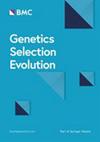Estimating the genetic parameters of resilience toward known and unknown disturbances in sheep using wool fibre diameter and body weight variability
IF 3.1
1区 农林科学
Q1 AGRICULTURE, DAIRY & ANIMAL SCIENCE
引用次数: 0
Abstract
General resilience in animals can be quantified by analysing the variability in longitudinal data. However, it is unclear whether resilience indicators derived from different longitudinal data series can predict resilience to known or unknown disturbances in sheep. This study aimed to use two sources of longitudinal data, wool fibre diameter and body weight, to develop potential indicators for resilience to the known stress of weaning and overall resilience to unknown disturbances. The genetic parameters of these traits were assessed, along with the genetic correlations between traits from different data series and different definitions of resilience. Additionally, correlations between resilience indicators, health and production traits were estimated to evaluate the suitability of including resilience indicators in breeding programs. Fibre diameter and body weight records from approximately 6500 yearling Merino sheep were used to estimate four resilience indicators of resilience towards unknown disturbances: log-transformed variance (Lnvar), lag-1 Auto (Auto), skewness (Skewness) and absolute difference in the deviations (ABS) from these curves. Three other traits, rate of change in the response and recovery (ROC_response and ROC_recovery) and area between curves (ABC) during a known disturbance of weaning, were also estimated. Resilience indicators were found to be lowly heritable (0.03 ± 0.01 to 0.18 ± 0.04). Genetic correlations between the general resilience indicator and the indicator of resilience to weaning stress were generally moderate, particularly in the wool fibre diameter data, suggesting these may represent similar traits. Genetic correlations between resilience indicators derived from wool fibre diameter and body weight data were typically weak to moderate, which indicates that they possibly capture different aspects of resilience. The genetic correlations between resilience indicators and health traits were mostly low, except for body condition score. Correlations between resilience and production traits were low to moderate and favourable. Resilience indicators based on deviations in wool fibre diameter and body weight can be used to potentially select animals that are less affected by environmental disturbances. The genetic correlations between resilience indicators and health and production traits suggest that these traits could be included in breeding programs to improve resilience without adversely affecting production traits.利用羊毛纤维直径和体重变异估计绵羊对已知和未知干扰的恢复力的遗传参数
动物的一般恢复力可以通过分析纵向数据的可变性来量化。然而,尚不清楚来自不同纵向数据系列的弹性指标是否可以预测绵羊对已知或未知干扰的弹性。本研究旨在利用两种纵向数据来源,羊毛纤维直径和体重,以开发对已知断奶应激和对未知干扰的整体恢复能力的潜在指标。分析了这些性状的遗传参数,以及不同数据序列和不同弹性定义性状之间的遗传相关性。此外,还估计了恢复力指标、健康和生产性状之间的相关性,以评估将恢复力指标纳入育种计划的适用性。利用约6500只美利奴羊的纤维直径和体重记录,估计了对未知干扰的弹性的4个指标:对数变换方差(Lnvar)、lag-1 Auto (Auto)、偏度(skewness)和这些曲线的绝对偏差差(ABS)。另外三个特征,在已知的断奶干扰期间,反应和恢复的变化率(ROC_response和ROC_recovery)和曲线间面积(ABC)也被估计。恢复力指标的可遗传性较低(0.03±0.01 ~ 0.18±0.04)。一般恢复力指标和断奶应激恢复力指标之间的遗传相关性一般是中等的,特别是在羊毛纤维直径数据中,这表明它们可能代表相似的性状。从羊毛纤维直径和体重数据得出的弹性指标之间的遗传相关性通常为弱至中等,这表明它们可能捕获了弹性的不同方面。韧性指标与健康性状的遗传相关性除体质评分外,其余均较低。恢复力与生产性状的相关性为低至中等和有利。基于羊毛纤维直径和体重偏差的弹性指标可用于潜在地选择受环境干扰影响较小的动物。抗逆性指标与健康和生产性状之间的遗传相关性表明,这些性状可以纳入育种计划,以提高抗逆性,而不会对生产性状产生不利影响。
本文章由计算机程序翻译,如有差异,请以英文原文为准。
求助全文
约1分钟内获得全文
求助全文
来源期刊

Genetics Selection Evolution
生物-奶制品与动物科学
CiteScore
6.50
自引率
9.80%
发文量
74
审稿时长
1 months
期刊介绍:
Genetics Selection Evolution invites basic, applied and methodological content that will aid the current understanding and the utilization of genetic variability in domestic animal species. Although the focus is on domestic animal species, research on other species is invited if it contributes to the understanding of the use of genetic variability in domestic animals. Genetics Selection Evolution publishes results from all levels of study, from the gene to the quantitative trait, from the individual to the population, the breed or the species. Contributions concerning both the biological approach, from molecular genetics to quantitative genetics, as well as the mathematical approach, from population genetics to statistics, are welcome. Specific areas of interest include but are not limited to: gene and QTL identification, mapping and characterization, analysis of new phenotypes, high-throughput SNP data analysis, functional genomics, cytogenetics, genetic diversity of populations and breeds, genetic evaluation, applied and experimental selection, genomic selection, selection efficiency, and statistical methodology for the genetic analysis of phenotypes with quantitative and mixed inheritance.
 求助内容:
求助内容: 应助结果提醒方式:
应助结果提醒方式:


